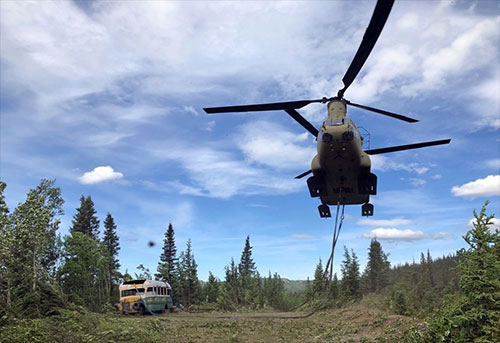
National Guard airlifts 'Into the Wild' bus out of Alaska wildernessBy Sgt. Seth LaCount, Alaska National Guard
June 22, 2020
In a coordinated effort with the Department of Natural Resources, 12 Alaska Army National Guardsmen assigned to 1st Battalion, 207th Aviation Regiment, airlifted the abandoned bus to a secure site. "After studying the issue closely, weighing many factors and considering a variety of alternatives, we decided it was best to remove the bus from its location on the Stampede Trail," said Corri A. Feige, commissioner for the Department of Natural Resources. "We're fortunate the Alaska Army National Guard could do the job as a training mission to practice airlifting vehicles, at no cost to the public or additional cost to the state."
The abandoned vehicle that sat 25 miles west of the Parks Highway near Healy, known as "Bus 142," or the "Magic Bus," was popularized by John Krakauer's 1996 book "Into the Wild," and Sean Penn's film adaptation in 2007 that chronicles the story of 24-year-old adventurer Chris McCandless, who spent the summer in the bus in 1992 and died of starvation after 114-days. Numerous travelers have sought to reach the bus by retracing McCandless' steps, and many have come to harm or required search-and-rescue services while hiking in harsh weather or crossing the rain- and meltwater-swollen Teklanika or Savage rivers. There were 15 bus-related search-and-rescue operations by the state between 2009 and 2017, according to DNR reports. In February, Alaska State Troopers rescued five Italian hikers, one of whom suffered severe frostbite. Travelers from Switzerland and Belarus drowned in 2010 and 2019, prompting public outcry – particularly among Alaskans – to reduce or eliminate the hazard. "We encourage people to enjoy Alaska's wild areas safely, and we understand the hold this bus has had on the popular imagination," said Feige. "However, this is an abandoned and deteriorating vehicle that was requiring dangerous and costly rescue efforts, but more importantly, was costing some visitors their lives. I'm glad we found a safe, respectful and economical solution to this situation." Under the oversight of the DNR, the 1-207th AVN pilots, flight engineers, crew chiefs and mechanics arrived via a UH-60 Black Hawk helicopter to clear vegetation and obstacles and ensure a safe rigging operation. Holes were cut in the roof and floor of the vehicle so dual point chain kits could be secured to the bus's frame. Employees from the DNR and the Department of Transportation and Public Facilities removed boulders that had blocked the surface entrance from Stampede road to the materials site, which served as an interim staging point. "This was a tremendous training opportunity for our heavy lift unit and a great way to lend a helping hand to our partners in the DNR and Alaskans everywhere," said Maj. Zachary Miller, an executive officer with 1-207th AVN and primary pilot for the extraction. "The department initially reached out to us with the goal of reducing the number of search-and-rescue cases that resulted from folks trying to reach the bus who may not necessarily be fully prepared for the trip," Miller said. "Certainly, Alaska's landscape can be treacherous in many areas of the state, but the bus's proximity to these rivers is what makes it particularly dangerous." Under Miller's leadership, the Army National Guard employed a CH-47 Chinook, an American twin-engine, tandem-rotor, heavy-lift helicopter, to execute "Operation Yutan" and extracted the bus. The aircrew also ensured the safekeeping and safe transportation of a suitcase that holds sentimental value to the McCandless family. Feige said the bus will be stored at a secure site while the DNR considers options for its permanent disposition. The department is discussing whether to display the bus at a safe location. "Conducting this sling load was definitely non-standard," Miller said. "We took our enlisted Soldiers with the most experience and expertise in this area to develop the best and safest solution. Like any mission, we were prepared to adjust along the way and I was confident that our crews were up for the challenge."
Edited By Mary Kauffman, SitNews
Source of News:
|
||||
